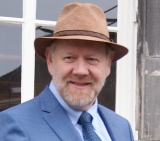The ISGs: Intrinsic Sustainability Goals This page is based on section 12.1 of the textbook Fundamentals of Sustainable Development, edition 2025. > The numbers 821 till 823 refer to the Notes. > See the Table of Contents for the context of this section. |
In search of a dream
It may be peculiar, but if you look for sources of inspiration to dream about a good and sustainable future of the global society, the current transitions do not really offer what you are looking for. Take the energy transition, which is supposed to result in the global economy eventually becoming climate-neutral. That transition is mostly about what we do not want. No more climate change. No further sea level rise. No scorched lands, absurdly strong hurricanes, extinction of the Gulf Stream. And especially no tipping points with unpredictable consequences. Thanks to climate neutrality, which sounds like a concrete goal, but is not really a goal but a means to achieve a goal. What goal? What dream?
Other transitions don't really help either. Those of floating cities, of nature conservation and of radically altered agricultural and food chains are about: no flooded homes, no dying ecosystems, no Sixth Extinction, no crop failures or refugee flows of hundreds of millions.
But what do we want?
The SDGs
Nor do the SDGs really help us dream about where we want to go as a society. Because quite a few SDGs are also about what we do not want.
| Some SDG Targets (abridged). By 2030: Target 1.1: No extreme poverty anymore. Target 2.1-2.2: No hunger and malnutrition anymore. Target 3.1-3.3: Much lower number of maternal, infant and epidemic deaths. Target 5.2-5.3: No sexual exploitation or genital mutilation of women and girls. Target 14.1: Less marine pollution. Target 16.1-16.2: No violence, abuse, trafficking or torture of children. |
|
Those goals are not about a dream at all: they are about the disappearance of a nightmare. Views of a wonderful future they do not offer. 821
But not all SDG targets are formulated this way; there are also quite a few that do indicate what we would like to achieve.
| Some more SDG Targets (abridged). By 2030: Target 1.5: Resilience of poor and people in vulnerable situations. Target 1.a: Enhanced development cooperation. Target 2.4: Sustainable food production systems, resilient agricultural practices. Target 3.7: Universal access to sexual and reproductive health care. |
|
And yet, if you look more closely, even these do not offer a whole lot of inspiration. The first two, 1.5 and 1.a, clearly don't describe a desirable end goal, because they accept that poor people will still exist in 2030 and development assistance will be needed. Which actually makes sense, because that really won't be over in such a short time.
That is also the immediate objection to the other two goals, 2.4 and 3.7. They may be part of a desired end state, but the idea that they will be achieved by 2030 is totally unrealistic, because for 2.4, a deeply ingrained global system will have to make way for a completely new, complex structure, and for 3.7, cultural or even regime change, including amended legislation, will have to take place in a lot of countries. Both of these can only be done through transitions, and if that might ever succeed, it will in any case take much longer than the 15 years of the SDGs.
So if you want to dream of a desired future world, you have to look for other sources. Or invent them yourself, of course.
Glued-on sustainability
That the SDGs do not help to dream is no wonder, because the SDGs - a political compromise between all the world's influential countries and institutions - are not meant for that at all: they do not aim at transitions. If some SDGs may succeed in becoming a reality, it will be within the existing system. It will not change the structure and philosophy of the prevailing economic and political system. The sustainable improvements are only superficial; they are not embedded in new ways of thinking.
As a result, there is a constant risk that the sustainable successes achieved will relapse, after which the old problems return: poverty, hunger, violence and you name it. The successes achieved are glued-on sustainability, 822 which is not stable: they will only survive as long as we continue to actively monitor them. They are 'insecurely attached'. If we do not pay attention for a moment, everything blows away again.
Intrinsic Sustainability
One of the characteristics of transitions is, according to Chapter 7: They are irreversible: the old situation never returns. During transitions, the systems themselves change, as a result of new paradigms. When, through such transitions, sustainability becomes deeply embedded and anchored in our thinking and in our structures, intrinsic sustainability is achieved, which is maintained even when we direct our attention to something else.
Intrinsic Sustainability Goals (ISGs)
Since transitions are known for their ability to bring about and even anchor the seemingly impossible, they offer us the space to dream. With the SDGs and current transitions mostly telling us what we do not want, the main question is: what do we want? What is our dream, what do we want to work on with all our energy and passion? What kind of world do we want to live in, or better yet, as figure 10.8 put it:
What kind of world will our great-grandchildren want to live in?
Obviously, there is no universal answer to that question. If you put it to a hundred people, you will probably get at least fifty different answers. But: there is a good chance that a number of elements of such a desired future can be found that everyone, or at least many, agree with. You could call those the Intrinsic Sustainability Goals, abbreviated to ISGs. Some of those ISGs could be, for example, the following:
| A proposal for some Intrinsic Sustainability Goals (ISGs) Rights: Responsibility: Division: Value: Stability: Sustainable: |
|
A few comments on these ISGs. First, they are indeed, as their name suggests, goals, not pathways. In other words, they only give an outline of an end state to be achieved, the 'dream'. They tell nothing about the path towards them, or a detailed interpretation of them.823 For example, in an intrinsically sustainable world, does money still exist; and if so, would present-day people recognise it as money at all? That question is not so strange, just think: would people from 1900 believe you if you assured them that the numbers on your smartphone are real money?
Nor do the proposed ISGs indicate how the transition from ownership to responsibility and care can be made. Or how the value of emotions and beauty can be expressed in a real way - whether in 'money' or not. And whether a "reasonable distribution of income and property" will put an end to absurd wealth. So there is a lot to explore.
It is a learning society that can make this journey of discovery, as discussed in the continuation of Chapter 12 of the textbook Fundamentals of Sustainable Development, edition 2025.

